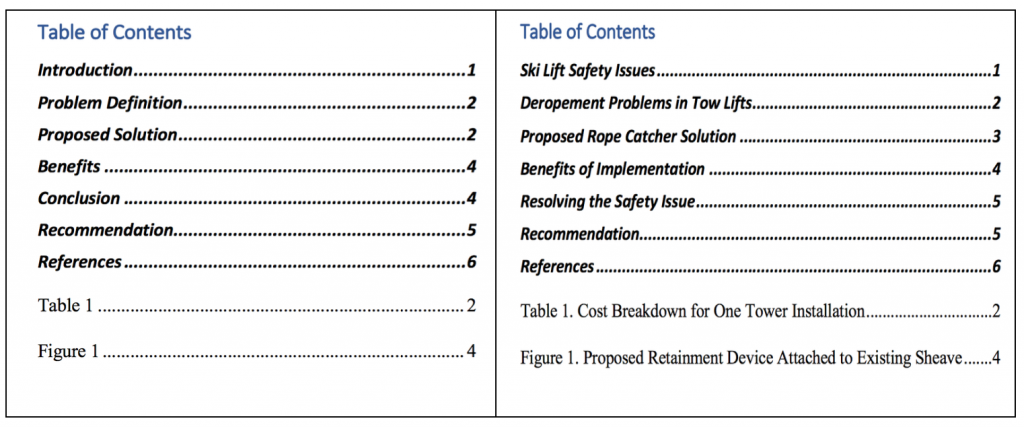2.3: Choosing Headings
Learning Objectives
- Identify the roles of headings in technical documents
- Understand and apply the principles for designing headings
Why Are Headings Important in Technical Documents?
Headings are standard features of technical documents that serve several important functions:
- provide organizational overview of the document
- show logical development of ideas
- show hierarchical relationship of ideas (headings, sub-headings)
- enable the reader to scan and read selectively
- increase readability of the document by providing breaks and passive space
What Are the Types of Headings?
Functional Headings
Functional headings are used in documents that have consistent structures, such as science lab reports, when each section must fulfill a particular function. For example, the headings for a lab report will likely include the following:
- Introduction
- Materials
- Procedure/Methodology
- Data/Results
- Discussion/Conclusions
- References
Descriptive Headings
Technical reports that are usually not so strictly organized or predictable should use descriptive headings. Descriptive headings use concrete, descriptive language to tell the reader what to expect from the content of each section. Readers will find it much more helpful if headings concretely describe the content of each section. Using descriptive headings will also result in an easily usable document; that is, the reader will easily be able to find information.
Note the differences in the two Tables of Contents in Figure 2.3.A., each generated automatically from headings within their respective documents. What is the benefit of using descriptive headings (Table of Contents on right) versus functional headings (Table of Contents on left)?

Figure 2.3.A: Functional vs. Descriptive Headings
What Are the General Principles for Designing Headings?
When designing the headings in your document, keep in mind these general principles:
- Hierarchical Relationship of Ideas: Use font size, boldness, typography and color to indicate the relative importance of ideas and how they inter-connect. In general, first level headings are larger and bolder than second and subsequent level headings.
- Consistency: If you use headings, every section must have a heading. Make sure your headings at each level are consistent in design (font, size, color, indentation, etc.) Use consistent, parallel phrasing as well.
- Readability: Leave passive space above and below headings. Leave slightly more space above the heading than below it. As a general guideline, use two-to-four headings per page in short reports. Avoid overusing headings.
- Specificity: When relevant, use descriptive headings that inform the reader of the content of each section. Avoid vague headings, and avoid using too many headings. Headings may be formatted using an alpha or numeric system if there are many sub-sections.
Headings: Do AND Don’t
DO
- Use a sans serif font for your headings.
- Use descriptive (rather than functional) headings when appropriate for your document’s purpose.
- Make sure there is slightly more white space above a heading than below it.
- A heading must have a block of text below it. Remember to include a lead-in sentence below the heading when it is followed by a list, a figure, or table.
- Use shortcuts that might be available in your software to help you in formatting headings consistently and effectively.
DON’T
- Do not “stack” headings. Avoid stacking one heading directly below another. A heading is like a chapter title; it must have at least a sentence of information below it. Stacked headings can indicate inefficient organization of information.
- Do not overuse headings. Keep in mind that every sentence does not require its own heading, nor does every paragraph. Overuse of headings indicates an inefficient organization of ideas that needs revision.
- Do not use a heading to introduce a table, figure, or list. You must have text below a heading that introduces and explains the figure or table.
- Do not create “lone headings.” Ideally, a heading should have at least one, often several, paragraphs of text below it.
- Don’t refer to a heading as “this” in the body text below it. Begin your sentence as if the heading were not there. Never start a new section with a pronoun that refers to a previous idea.
TRY IT
Exercise 2.3.A Working with Headings
Review the following sets of descriptive headings. Edit to make the sets parallel.
Set 1:
Thermal Analysis
Analyzing of the Structure
Analysis with Regard to Mechanics
Set 2:
Soft Robot Design
Using Soft Robots
Explore the Application of Soft Robots
Set 3:
Antibiotic Resistance Assessing and Analysis
Test for Antibiotic Resistance
Prediction of Antibiotic Resistance
References & Attributions
Attributions
Content on this page is adapted from Technical Writing Essentials by Suzan Last, which is is licensed under a Creative Commons Attribution 4.0 International License, except where otherwise noted.

